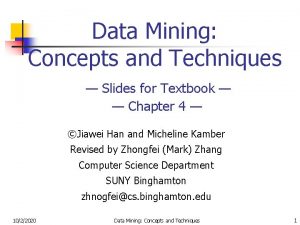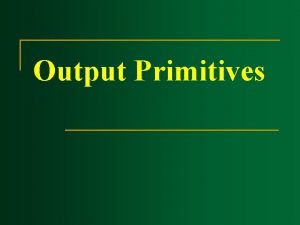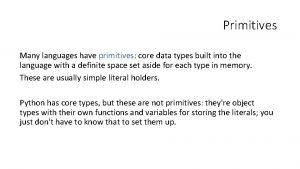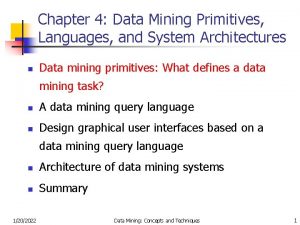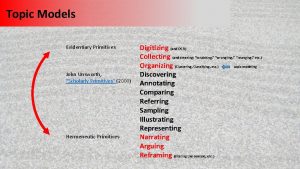Why Data Mining Primitives and Languages Finding all




















- Slides: 20

Why Data Mining Primitives and Languages? • Finding all the patterns autonomously in a database? — unrealistic because the patterns could be too many but uninteresting • Data mining should be an interactive process – User directs what to be mined • Users must be provided with a set of primitives to be used to communicate with the data mining system • Incorporating these primitives in a data mining query language – More flexible user interaction – Foundation for design of graphical user interface – Standardization of data mining industry and practice January 5, 2022 Data Mining: Concepts and Techniques 1

What Defines a Data Mining Task ? • Task-relevant data • Type of knowledge to be mined • Background knowledge • Pattern interestingness measurements • Visualization of discovered patterns January 5, 2022 Data Mining: Concepts and Techniques 2

Task-Relevant Data (Minable View) • Database or data warehouse name • Database tables or data warehouse cubes • Condition for data selection • Relevant attributes or dimensions • Data grouping criteria January 5, 2022 Data Mining: Concepts and Techniques 3

Types of knowledge to be mined • Characterization • Discrimination • Association • Classification/prediction • Clustering • Outlier analysis • Other data mining tasks January 5, 2022 Data Mining: Concepts and Techniques 4

Background Knowledge: Concept Hierarchies • Schema hierarchy – E. g. , street < city < province_or_state < country • Set-grouping hierarchy – E. g. , {20 -39} = young, {40 -59} = middle_aged • Operation-derived hierarchy – email address: dmbook@cs. sfu. ca < department < university < country login-name • Rule-based hierarchy – low_profit_margin (X) <= price(X, P 1) and cost (X, P 2) and (P 1 - P 2) < $50 January 5, 2022 Data Mining: Concepts and Techniques 5

Measurements of Pattern Interestingness • Simplicity e. g. , (association) rule length, (decision) tree size • Certainty e. g. , confidence, P(A|B) = #(A and B)/ #(B), classification reliability or accuracy, certainty factor, rule strength, rule quality, discriminating weight, etc. • Utility potential usefulness, e. g. , support (association), noise threshold (description) • Novelty not previously known, surprising (used to remove redundant rules, e. g. , Canada vs. Vancouver rule implication support ratio) January 5, 2022 Data Mining: Concepts and Techniques 6

Visualization of Discovered Patterns • Different backgrounds/usages may require different forms of representation – E. g. , rules, tables, crosstabs, pie/bar chart etc. • Concept hierarchy is also important – Discovered knowledge might be more understandable when represented at high level of abstraction – Interactive drill up/down, pivoting, slicing and dicing provide different perspectives to data • Different kinds of knowledge require different representation: association, classification, clustering, etc. January 5, 2022 Data Mining: Concepts and Techniques 7

A Data Mining Query Language (DMQL) • Motivation – A DMQL can provide the ability to support ad-hoc and interactive data mining – By providing a standardized language like SQL • Hope to achieve a similar effect like that SQL has on relational database • Foundation for system development and evolution • Facilitate information exchange, technology transfer, commercialization and wide acceptance • Design – DMQL is designed with the primitives described earlier January 5, 2022 Data Mining: Concepts and Techniques 8

Syntax for DMQL • Syntax for specification of – task-relevant data – the kind of knowledge to be mined – concept hierarchy specification – interestingness measure – pattern presentation and visualization • Putting it all together—a DMQL query January 5, 2022 Data Mining: Concepts and Techniques 9

Syntax: Specification of Task-Relevant Data • use database_name, or use data warehouse data_warehouse_name • from relation(s)/cube(s) [where condition] • in relevance to att_or_dim_list • order by order_list • group by grouping_list • having condition January 5, 2022 Data Mining: Concepts and Techniques 10

Specification of task-relevant data January 5, 2022 Data Mining: Concepts and Techniques 11

Syntax: Kind of knowledge to Be Mined • Characterization Mine_Knowledge_Specification : : = mine characteristics [as pattern_name] analyze measure(s) • Discrimination Mine_Knowledge_Specification : : = mine comparison [as pattern_name] for target_class where target_condition {versus contrast_class_i where contrast_condition_i} analyze measure(s) E. g. mine comparison as purchase. Groups for big. Spenders where avg(I. price) >= $100 versus budget. Spenders where avg(I. price) < $100 analyze count January 5, 2022 Data Mining: Concepts and Techniques 12

Syntax: Kind of Knowledge to Be Mined (cont. ) – Association Mine_Knowledge_Specification : : = mine associations [as pattern_name] [matching <metapattern>] E. g. mine associations as buying. Habits matching P(X: custom, W) ^ Q(X, Y)=>buys(X, Z) n Classification Mine_Knowledge_Specification : : = mine classification [as pattern_name] analyze classifying_attribute_or_dimension n Other Patterns clustering, outlier analysis, prediction … January 5, 2022 Data Mining: Concepts and Techniques 13

Syntax: Concept Hierarchy Specification • To specify what concept hierarchies to use hierarchy <hierarchy> for <attribute_or_dimension> • We use different syntax to define different type of hierarchies – schema hierarchies define hierarchy time_hierarchy on date as [date, month quarter, year] – set-grouping hierarchies define hierarchy age_hierarchy for age on customer as level 1: {young, middle_aged, senior} < level 0: all level 2: {20, . . . , 39} < level 1: young level 2: {40, . . . , 59} < level 1: middle_aged level 2: {60, . . . , 89} < level 1: senior January 5, 2022 Data Mining: Concepts and Techniques 14

Concept Hierarchy Specification (Cont. ) – operation-derived hierarchies define hierarchy age_hierarchy for age on customer as {age_category(1), . . . , age_category(5)} : = cluster(default, age, 5) < all(age) – rule-based hierarchies define hierarchy profit_margin_hierarchy on item as level_1: low_profit_margin < level_0: all if (price - cost)< $50 level_1: medium-profit_margin < level_0: all if ((price - cost) > $50) and ((price - cost) <= $250)) level_1: high_profit_margin < level_0: all if (price - cost) > $250 January 5, 2022 Data Mining: Concepts and Techniques 15

Specification of Interestingness Measures • Interestingness measures and thresholds can be specified by a user with the statement: with <interest_measure_name> threshold = threshold_value • Example: with support threshold = 0. 05 with confidence threshold = 0. 7 January 5, 2022 Data Mining: Concepts and Techniques 16

Specification of Pattern Presentation • Specify the display of discovered patterns display as <result_form> • To facilitate interactive viewing at different concept level, the following syntax is defined: Multilevel_Manipulation : : = roll up on attribute_or_dimension | drill down on attribute_or_dimension | add attribute_or_dimension | drop attribute_or_dimension January 5, 2022 Data Mining: Concepts and Techniques 17

Putting it all together: A DMQL query use database All. Electronics_db use hierarchy location_hierarchy for B. address mine characteristics as customer. Purchasing analyze count% in relevance to C. age, I. type, I. place_made from customer C, item I, purchases P, items_sold S, works_at W, branch where I. item_ID = S. item_ID and S. trans_ID = P. trans_ID and P. cust_ID = C. cust_ID and P. method_paid = ``Am. Ex'' and P. empl_ID = W. empl_ID and W. branch_ID = B. branch_ID and B. address = ``Canada" and I. price >= 100 with noise threshold = 0. 05 display as table January 5, 2022 Data Mining: Concepts and Techniques 18

Other Data Mining Languages & Standardization Efforts • Association rule language specifications – MSQL (Imielinski & Virmani’ 99) – Mine. Rule (Meo Psaila and Ceri’ 96) – Query flocks based on Datalog syntax (Tsur et al’ 98) • OLEDB for DM (Microsoft’ 2000) – Based on OLE, OLE DB for OLAP – Integrating DBMS, data warehouse and data mining • CRISP-DM (CRoss-Industry Standard Process for Data Mining) – Providing a platform and process structure for effective data mining – Emphasizing on deploying data mining technology to solve business problems January 5, 2022 Data Mining: Concepts and Techniques 19

Data Mining System Architectures • Coupling data mining system with DB/DW system – No coupling—flat file processing, not recommended – Loose coupling • Fetching data from DB/DW – Semi-tight coupling—enhanced DM performance • Provide efficient implement a few data mining primitives in a DB/DW system, e. g. , sorting, indexing, aggregation, histogram analysis, multiway join, precomputation of some stat functions – Tight coupling—A uniform information processing environment • DM is smoothly integrated into a DB/DW system, mining query is optimized based on mining query, indexing, query processing methods, etc. January 5, 2022 Data Mining: Concepts and Techniques 20
 Data mining primitives languages and system architecture
Data mining primitives languages and system architecture Mining complex types of data
Mining complex types of data Data mining languages and system architecture
Data mining languages and system architecture Mining multimedia databases
Mining multimedia databases Hey hey bye bye
Hey hey bye bye Difference between strip mining and open pit mining
Difference between strip mining and open pit mining Web text mining
Web text mining What is data mining and data warehousing
What is data mining and data warehousing Olap data mart
Olap data mart Olap data warehouse
Olap data warehouse Introduction to data warehousing and data mining
Introduction to data warehousing and data mining Strip mining vs open pit mining
Strip mining vs open pit mining Strip mining before and after
Strip mining before and after Data reduction in data mining
Data reduction in data mining What is missing data in data mining
What is missing data in data mining Concept hierarchy generation for nominal data
Concept hierarchy generation for nominal data Data reduction in data mining
Data reduction in data mining Data reduction in data mining
Data reduction in data mining Shell cube in data mining
Shell cube in data mining Data reduction in data mining
Data reduction in data mining Arsitektur data mining
Arsitektur data mining


